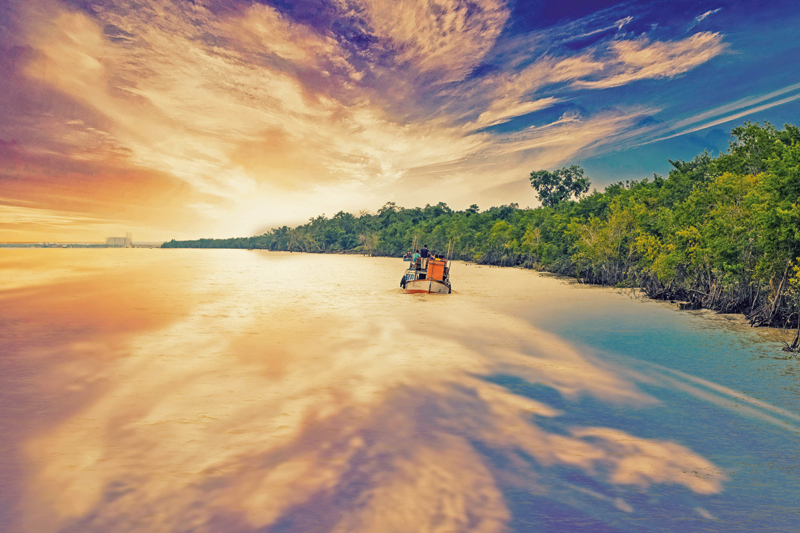

Whatever it is you like about travelling — whether it’s braving a marshy dense jungle, taking photographs of wildlife, exploring tropical saltwater forest or just mainly to escape the city humdrum — Sundarban, a cluster of more than hundred marshy islands and home to the largest mangrove forest ecosystem in the world is a perfect getaway for you.
Located in the southernmost part of the East Indian state of West Bengal, this 10,000 square kilometre mystic delta creating crisscross networks of river distributaries is strikingly crafted by the rivers Ganges and Brahmaputra flowing into the Bay of Bengal.



Constantly changing from dawn to dusk, the wetland is moulded on the equation of high tide and low tide at regular intervals throughout the day, which shapes up the topography of this mangrove forest.
As the water level increases due to early morning and late afternoon high tide, seventy per cent of the swamps are immersed in the water making it look more like a floating forest, and no sooner the water recedes to the lowest level, the salty marshes rich in silt deposits reveals its shiny texture and a diverse wilderness.
The low tide session creates a maze wherein run the estuaries in every possible direction. Within its heart species of trees forming canopies serves as home to more than 270 species of bird, 42 species of mammals, 35 reptiles and 8 amphibians species.
The name Sundarban is symbolic by itself. The word “Sundar” meaning beautiful and “ban” meaning forest, is as gorgeous as it could be. The name, as some suggest, is also said to be derived from a tree – Sundari – a mangrove species, with its spearhead-like breathing roots jutting out of the soggy ground, that thrives in these estuaries and owing its name to the forest. There are more than 300 species of flora and more than 25 mangrove species found here.
What has always allured me visiting this area are all the available choices of adventures. Though it is said that any jungle must be visited either in the winter or the summer months to experience the blooming and thriving flora and fauna, the same can never be expected in Sundarban.
Even in the middle of the monsoon month, the voyage through a houseboat along the Matla river (one of the distributaries) and then entering into the deep and narrow estuaries, creates a certain thrill. A splash of seasonal cloudburst in-between makes this landscape look even more enigmatic and enthralling.
With each passing hour as the swamp changes its shape and volume, the wildlife plays peekaboo. Animals like the spotted deer, crocodile, snakes and python, jungle foul, wild boar can be seen exhibiting their beauty as the land rises during the low tide. Sundarban has the largest population of tigers in whole of Asia. The marvel and the ruler of the marshland have both majestic and fierce tag to its regal presence. Prowling with glory — the Royal Bengal Tigers — brands Sundarban as India’s top-rated wildlife sanctuaries, has been inscribed as Unesco heritage site in 1997.
A paradise for biologist, photographers and documentarians, Sundarban can be well termed as dark beauty; unfolding nature’s twists and turns as rivers bend.
Your itinerary
must include:
— A day long cruise along the maze-like creeks
— Stay in one of the island resorts
— Visit the watch towers to spot animals that rule the swamp
— Watch the theatrical “BonoBibi” show (a legendary tale of how the forest deity protects fishermen against the deadly tiger attacks)
— Visit Hastings Palace built during the British Rule
— Take a tour to the Widow’s island
— Indulge yourself in the flavourful and sumptuous feast of the fresh catches which include Hilsa, jumbo prawns, crabs and other variety of fishes.
axisswati@gmail.com
Oman Observer is now on the WhatsApp channel. Click here



